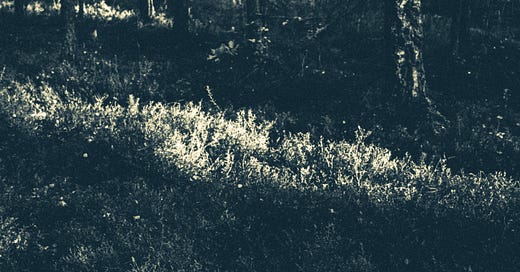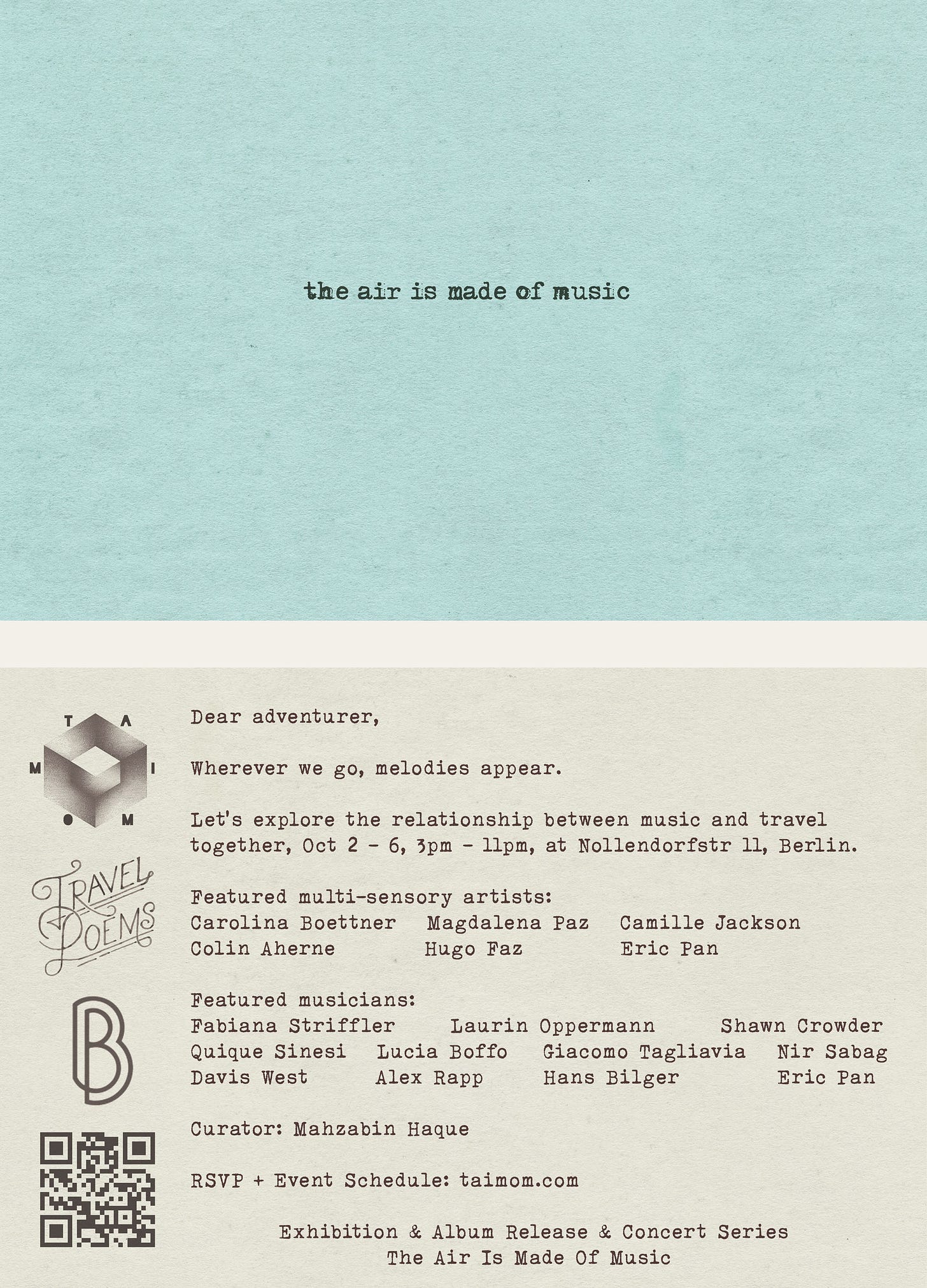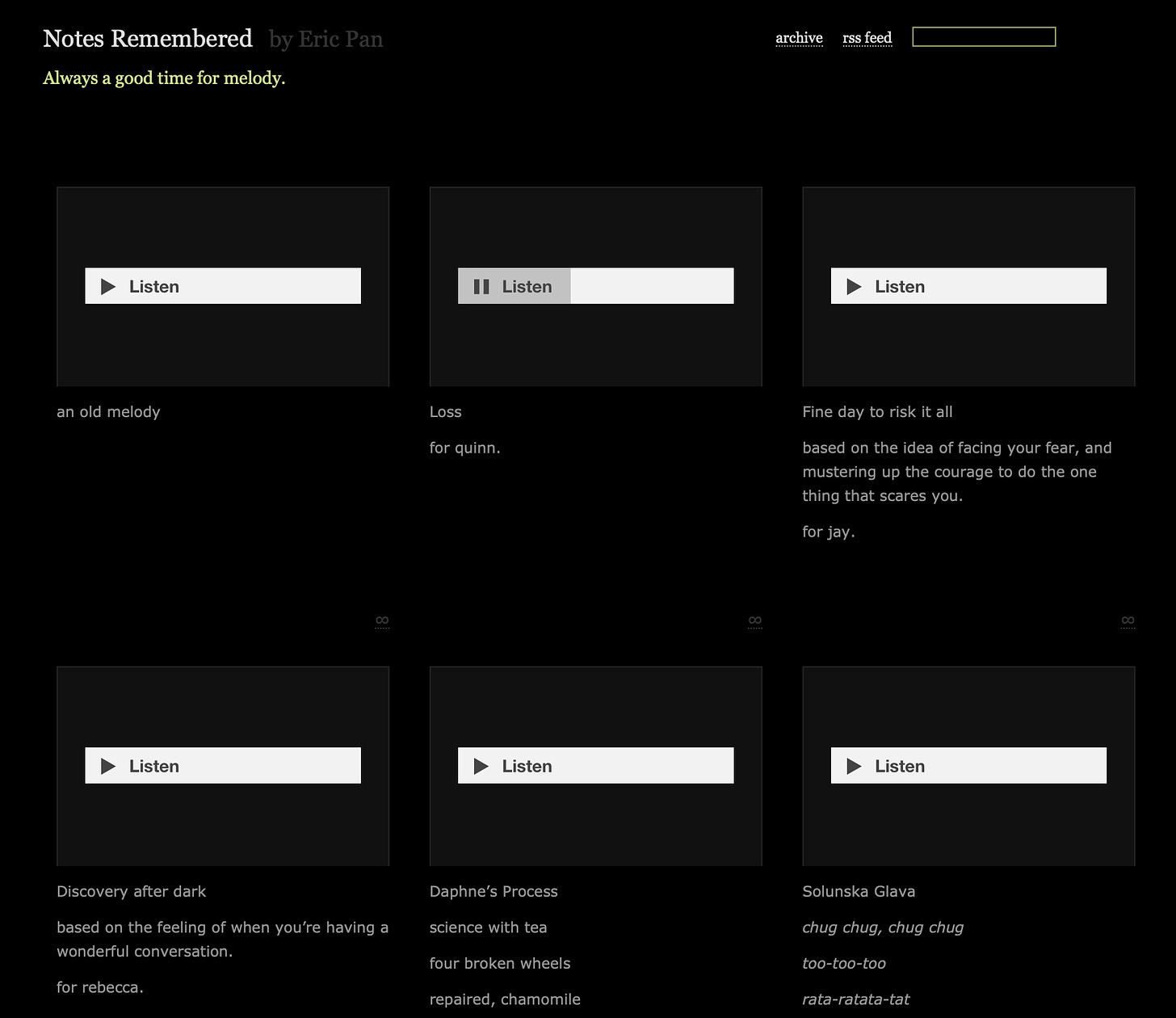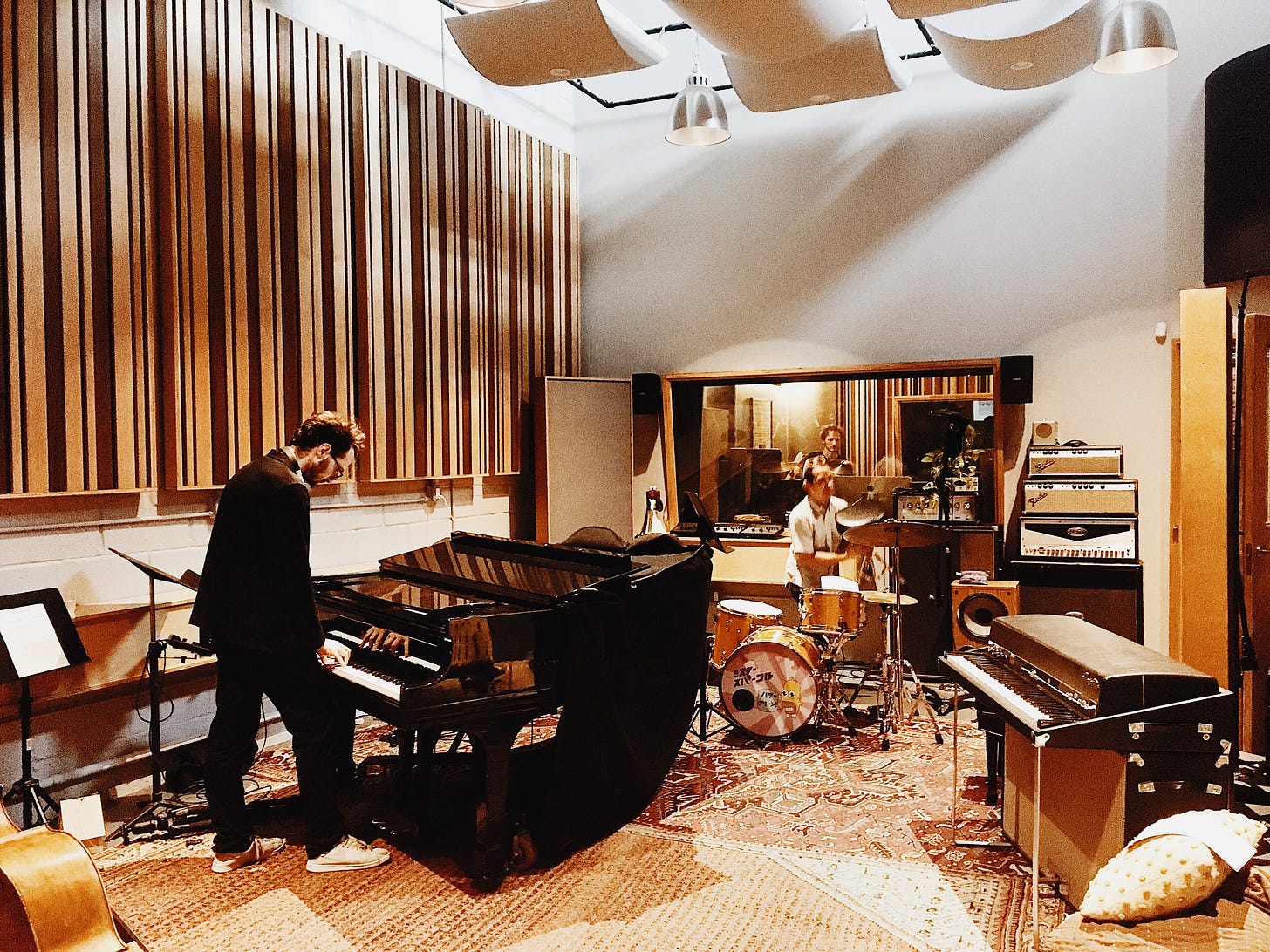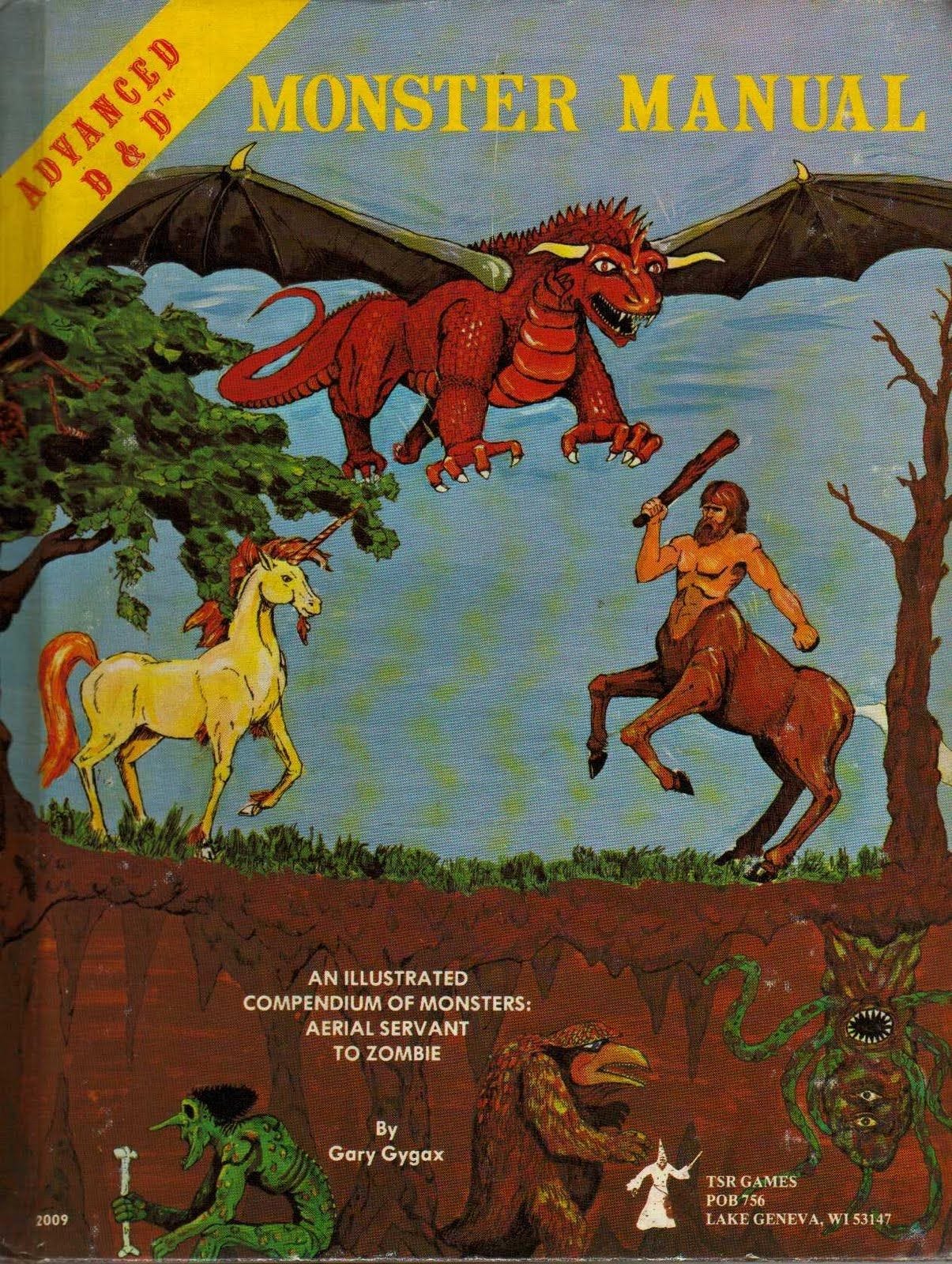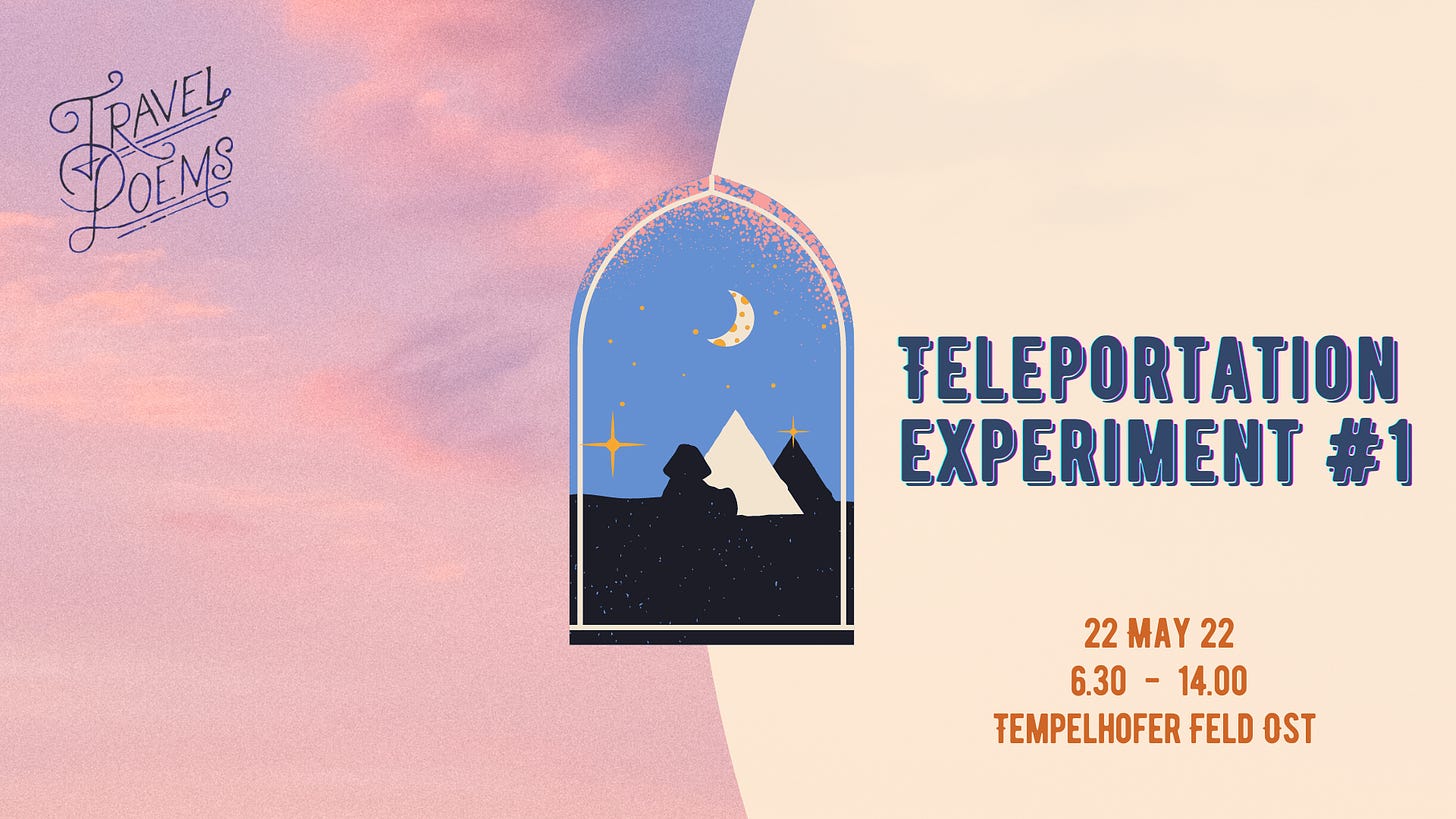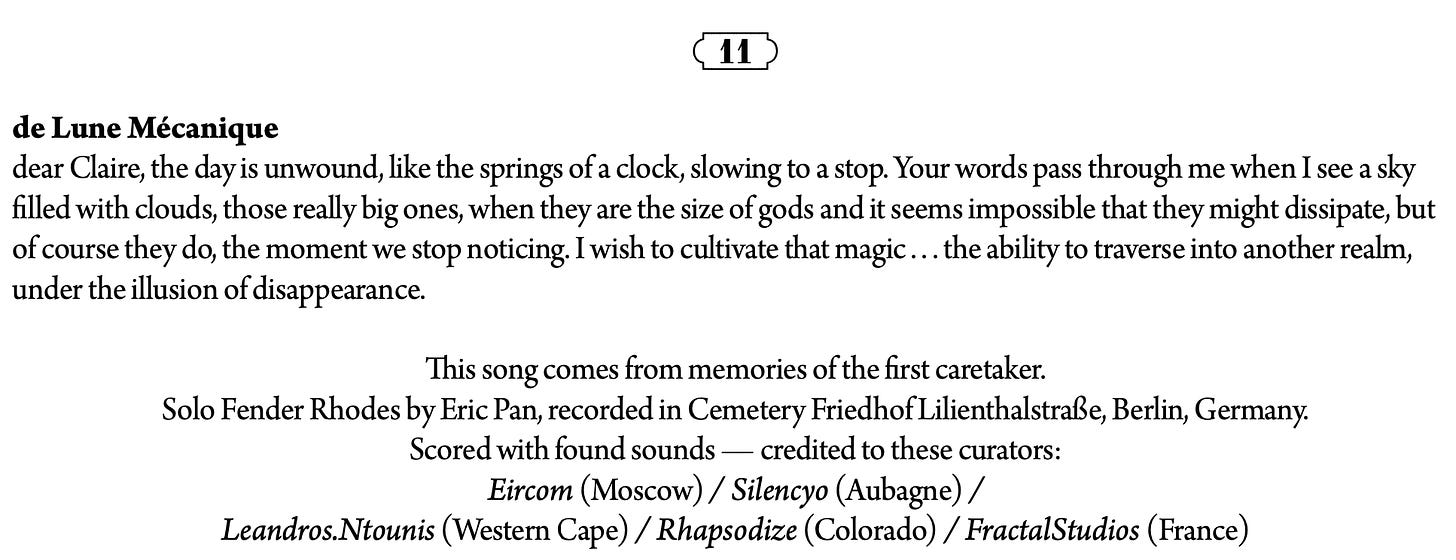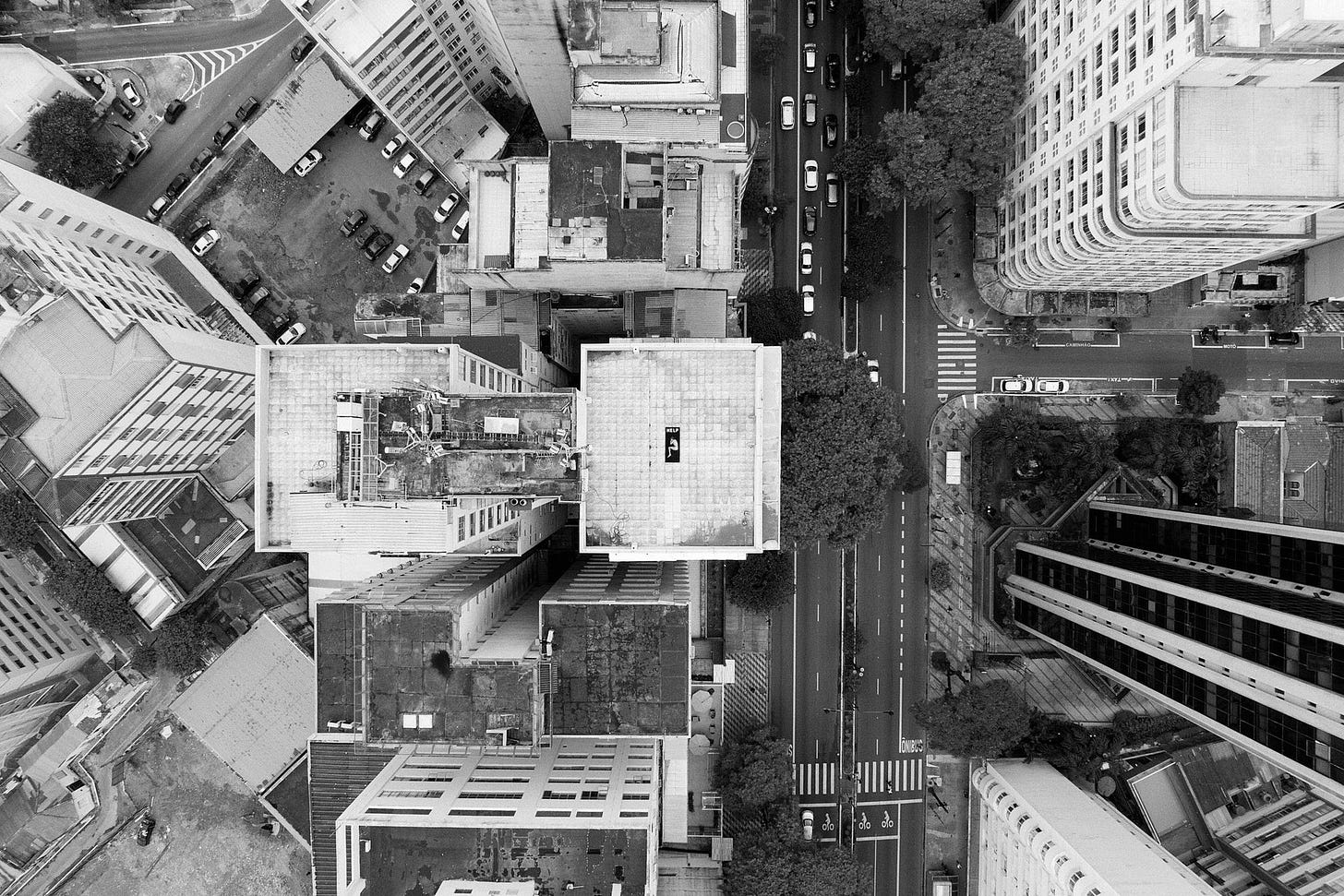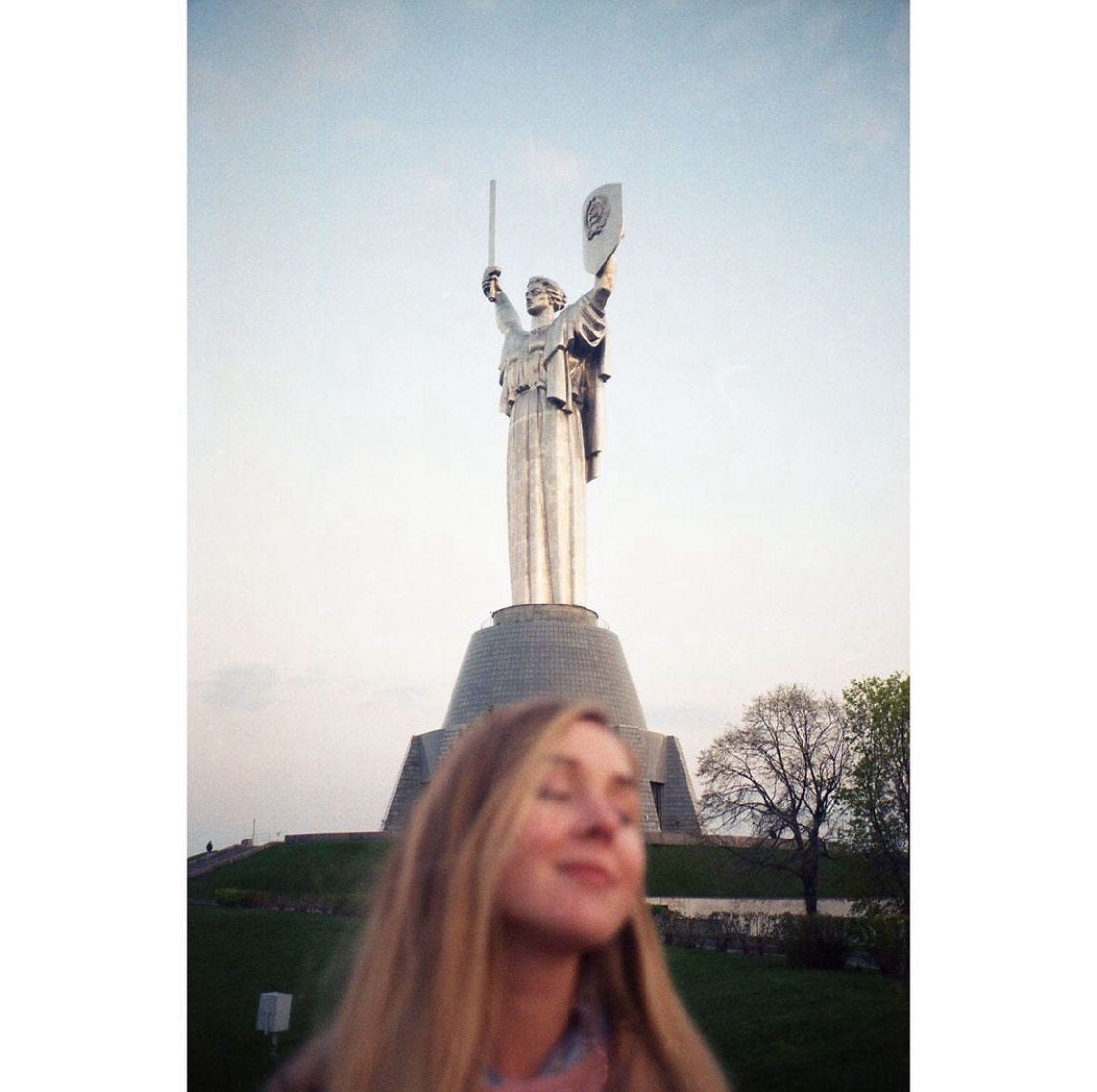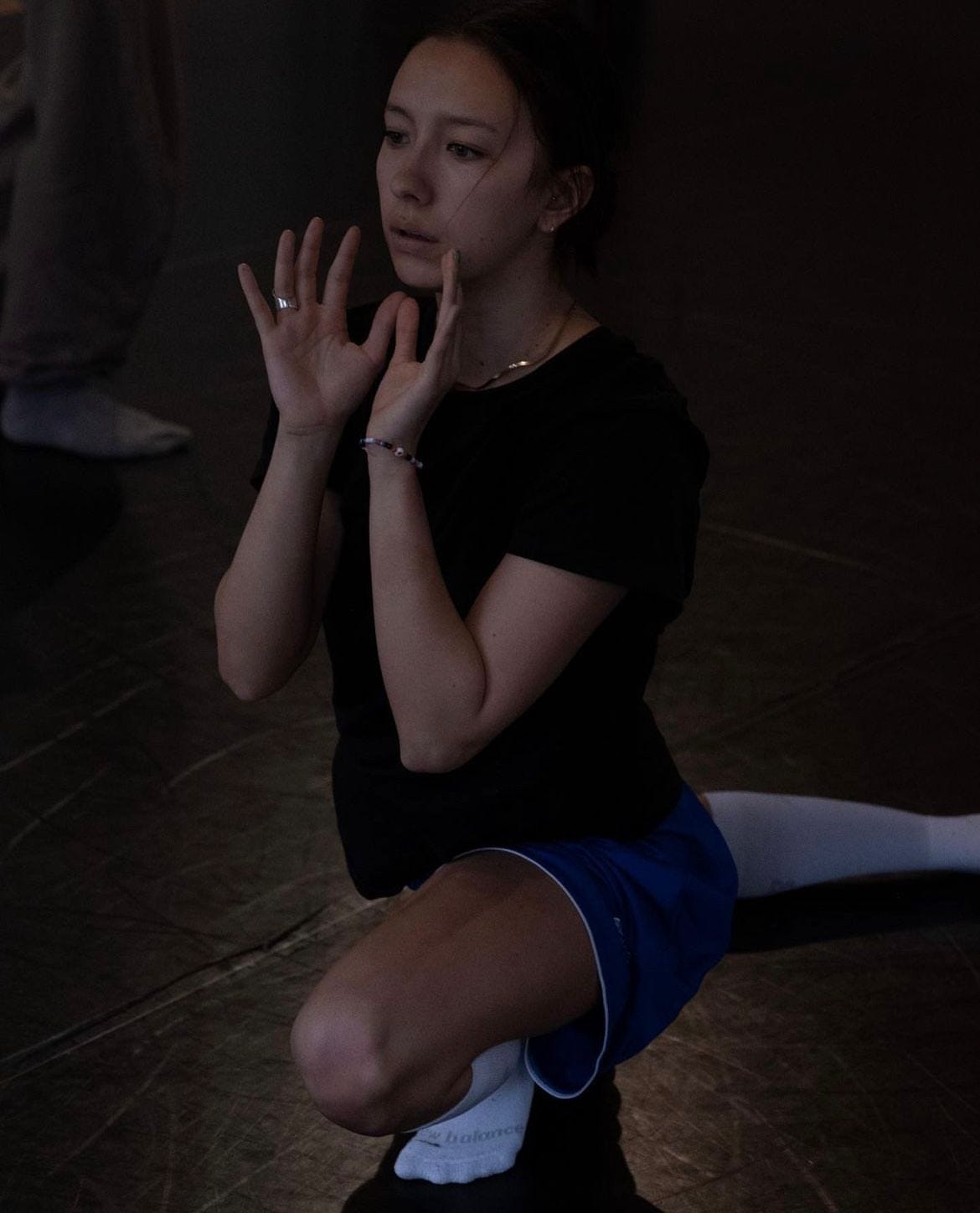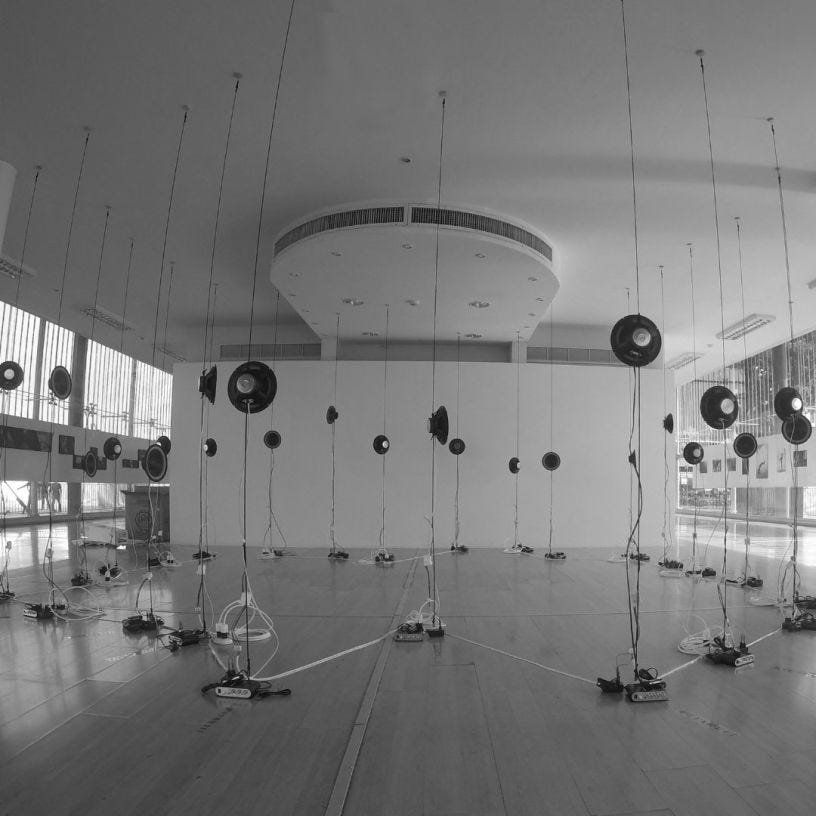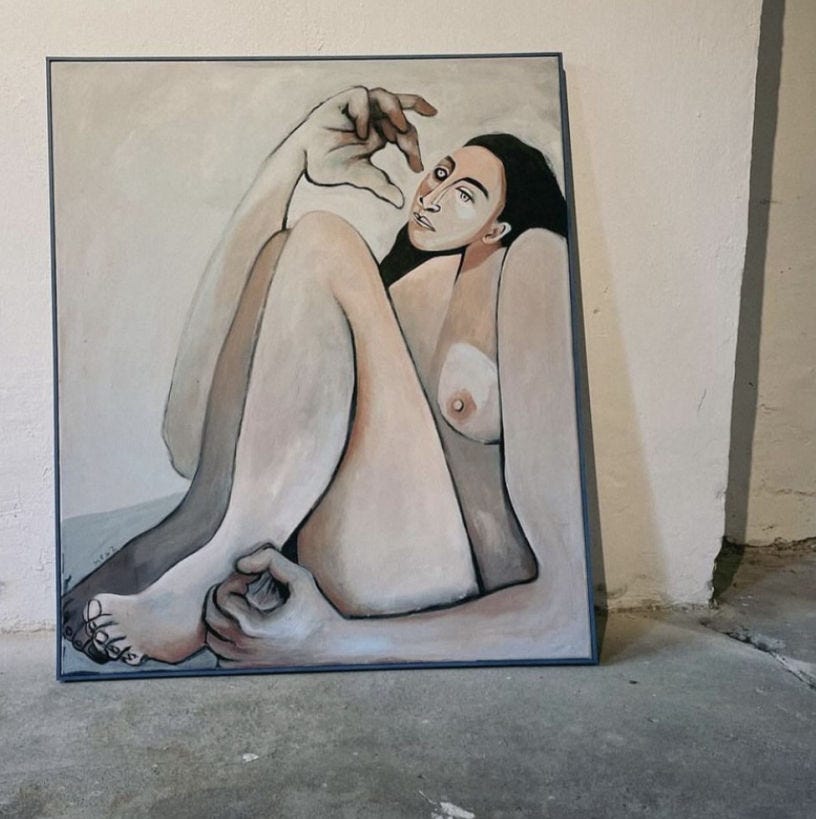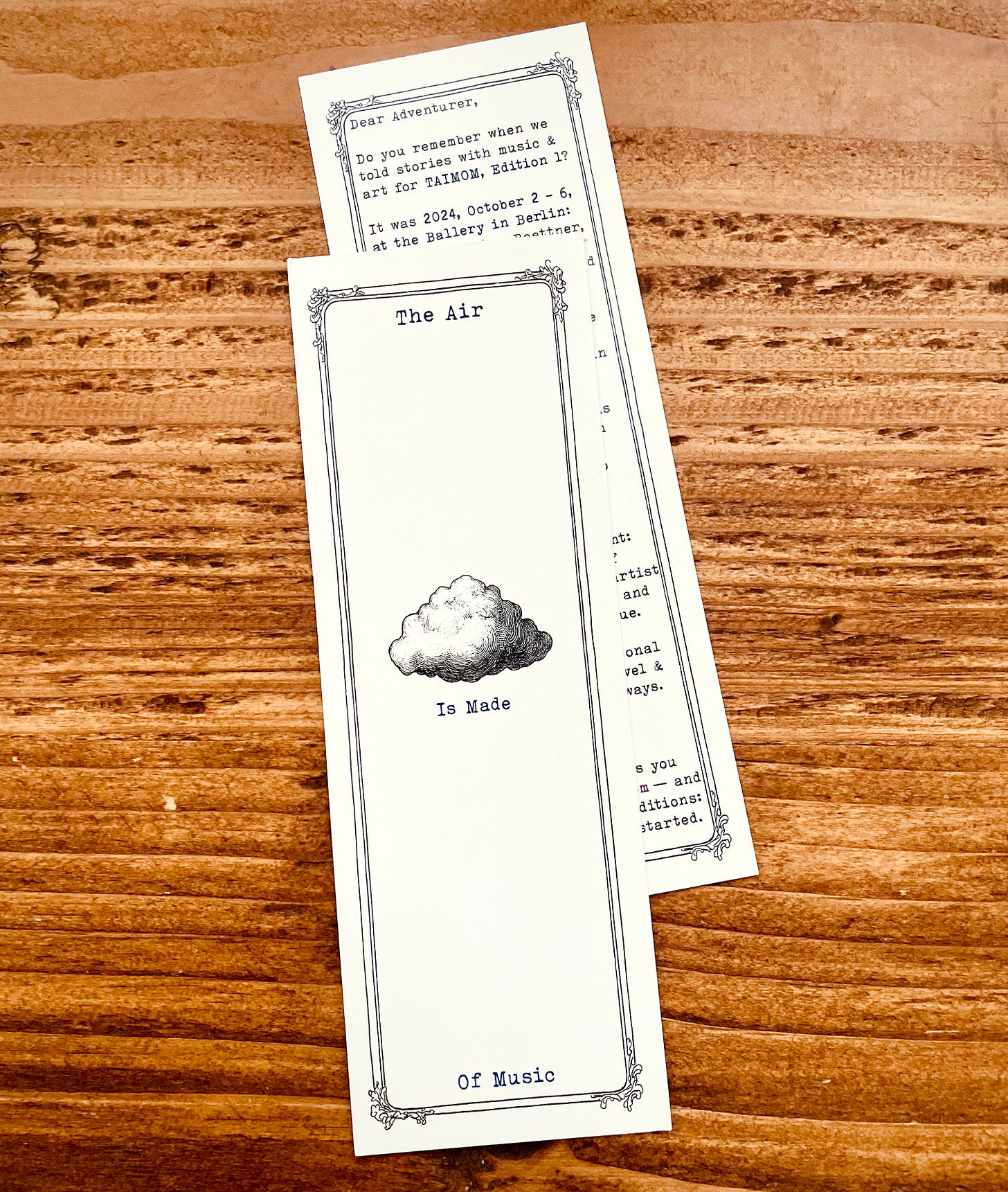Your stride lengthens as the shadows recede.
Glimmers of dawn through the easterly trees. Crossing the ravine on elevated tracks was . . . how long ago?
You’re still matching your pace to the railroad ties even though it stopped mattering after the bridge ended.
The forest blurs under your feet, and the metal rails have evolved from serviceable, to rusty and tattered, to now: nearly invisible, under carpets of moss.
It’s as though the longer you follow these tracks, the further back in time you go.
Abruptly, you meet a lake. Still, and shrouded in morning haze. The trees end — but the mossy railway continues, undaunted, underwater.
One canoe awaits you, tied to a dock, fishing rod mounted like a feather from a cap.
// Side B //
Aaand thank you for tuning in . . . you were listening to “Sequel to a Memory”, track 4 off the upcoming Travel Poems . Chapter 3 . There is no path back. The album’s out October 61, with release across worldwide streaming staggered for November 19. The photo, taken outside of Vilnius, Lithuania.
Accompanying this album release is the biggest show I’ve ever rustled up! 5 multi-disciplinary artists, and 10 phenomenal musicians, will respectively exhibit interpretations of songs from the Travel Poems trilogy, and play live-salon performances over 5 days and nights next week. Here’s the roster (RSVP + full event schedule at taimom.com) —
Yes, that’s the mind-blowing Quique Sinesi from Argentina, Grammy-winning classical guitarist. And yes, it’s the actual Shawn Crowder, drummer of Sungazer! I’m so lucky — and beyond chuffed that these Elements of Badassery are down to collaborate live with me at this very impromptu mini-festival.
The last few days, I wrote an essay about how Travel Poems led up to this exhibition2, and about how the entire 7+ year project resembles a cloud, from gathering to dissolution again. I’d love to share it with you:
From Travel Poems to The Air Is Made Of Music
1 — Gathering
It started with songs as gifts for friends.
In the summer of 2014, I asked people for topics to write songs about. Each friend’s bounty of ideas — one so concise, it contained a single word with no further explanation — conjured portals that appeared in an instant, leading to music I couldn’t have created on my own.
This led me to wonder about songs as gifts for places too.
Ever since I was four-years-old I’ve moved around different homes on different continents: travel, a constant companion. Maybe tied to that, new places buzz with possibilities.
The idea of making soundtracks for places created an expanse for exploration. I began carrying small keyboards with me when traveling.
Because I could write and refine compositions away from home, I started to think of these travel vignettes as postcards. I love postcards — that a postcard is connected to a place, reflective of a moment and an intention.
After a few years of on-the-go composing I noticed that when we travel around outside in the world, we also travel within ourselves. This was aided by Michael Crichton’s book Travels, though he discusses inward travel from the perspective of psychedelic drug experiences.
Being a jazz pianist for the majority of my regular music output kept me from believing that these on-the-go compositions could be viable songs. Some were extremely short, for one thing. It fell to longtime production friends Brian Trahan and Virgil Segal, to float the possibility, and help me envision a realm where the seeds of this music could take root.
(That’s the first “postcard for a place” I wrote, originally titled “Sunny Macedonia”.)
Many songs were already recorded somewhere in the world during the writing phase, and seemed to capture the air of their provenance, as if bottled and corked from the source.
For songs that needed to be recorded, we decided to continue the trajectory of “variety of pianos from different places”, now through active recruitment of pianos in various towns: one from New York City’s Steinway Hall, another a rumbling behemoth in an old German inn, and there a quirky spinet of unknown origin found at a Berlin flea market.
During the recording process I kept nursing the question of what world the music lived in. Though containing many improvised structures, too many songs stood distant from jazz idioms, swing, and the polyrhythmic source, for the collection to warrant being called “jazz”.
Nonetheless, we documented the music: mostly solo piano, a few duo and trio numbers with Nir Sabag (drums) and Hugo Reydet (bass) in Berlin — later enlisting C-Bass Chiriboga (drums) and Dean Torrey (bass) in New York as well.
Listening back, after recording 27 tracks, the music clarified its own purpose. To transport listeners to different places and experiences. A circle had closed, as plainly as M.C. Escher’s “Drawing Hands”: travel causes music / music causes travel.
2 — Storytelling
I would return repeatedly to the music itself to divine how Travel Poems should unfold.
27 was too many songs for a single album, and though I tried, I was not able to split it in two, so I tried a trilogy, which worked ideally for the material. The realization that the music had a transportive essence — owing to its origins? — pointed towards album-length adventures that could carry the listener through a journey.
The search began, for narrative soundscapes that evoked a strong sense of place, conjuring imagery redolent with the stuff of life: brewing tea, jumping from a cliff into the sea, fishing on a quiet lake. I ended up with a thousand found-sound recordings, themselves curated with care from around the world, requiring several weeks for assembly into stories that could cohesively score three musical adventures.
(Renamed “Bright Macedonia”, the song ended up on Travel Poems, recorded with Nir Sabag (drums) and Hugo Reydet (bass), and scored with soundscapes3. If you attend the Album Release concert next week in Berlin, you’ll hear us stretch out and take solos over it too.)
Endless decisions required during production/mixing/mastering — with Brian Trahan and Ruairi O’Flaherty — could be made swift by checking in with the now-maturing ethos of Travel Poems: “Does this help take the listener to a place?”
For the live show, I felt that the combination of music and sounds alone was insufficient to welcome listeners outside the frame of a musical performance, so I experimented with another addition: immersive storytelling.
During high school in Colorado, friends got together every week to play Dungeons and Dragons. These forms of live, transportive storytelling stuck with me; my resulting instinct for narrating second-person stories, rich in sensory detail, was indeed a natural fit for transportive experiences. I could describe environments for on-stage musicians to improvise to, for audience members to co-create with their imaginations.
These stories anchored instrumental music within vivid environments — and vice versa, provided live soundtracks to score those stories. Music grounds stories / stories ground music.
As a bonus: lines assumed to be present between listener and performer become translucent when the audience’s role as a co-creator of atmosphere and imagery increases.
3 — Invitations
Travel Poems has become a collection of varied pathways into music.
In 2019, access to a woodworking studio made possible some percolating ideas to build a Phone Booth “Teleporter”: an art installation on wheels that visitors step inside, to be transported by music and sound. The 2.5-meter-tall Teleporter was completed in a few months, built from salvaged German doors and windows over 100 years-old, housed in a new frame, and decorated as an object of curiosity: covered in multi-colored felt balls + woven fabrics.
When the Teleporter travels through public spaces, passersby (especially children) are drawn to its colors and out-of-place-ness: a beacon for the potential of exploration. Its height ensures visibility from a distance and its textures invite closeness, touch, and entrance through its swivel-open doors. Inside, a sequined-yet-soft “forest bed for the feet” greets visitors with care, and an antique telephone — with headphones resting atop — empowers interaction.
The written word was another pathway. When drafting the liner notes for Travel Poems, I expanded the mythology of each track through a postcard, written as one beams intimate thoughts to a loved one. Words on a postcard blossom from not just the place of their composition — but also the mood, the relationship between sender and receiver, their shared history.
I began releasing the Travel Poems albums during pandemic lockdowns, facilitating travel for everyone stuck at home — a story covered eloquently on-air by national public radio in the U.S. and syndicated worldwide. Chapter 1 came out in 2020, kicking off tours in Berlin and New York, and Chapter 2 in 2022, leading to new interviews, a “Favorite Album of the Year” award, and placement on the Spotify Editorial “All New Jazz”.
(“Oak Island” was picked for editorial selection at Spotify. Pretty unusual for a track with tons of soundscapes4 even before the music begins. Recorded with C-Bass Chiriboga (drums) and Dean Torrey (bass) in the Brooklyn session pictured above.)
Our release show for Chapter 2 was held in an art gallery in collaboration with two talented artists: a step towards multi-disciplinary offerings of Travel Poems. The subsequent tour required assembly of a third band, for coverage of my home country of Taiwan.
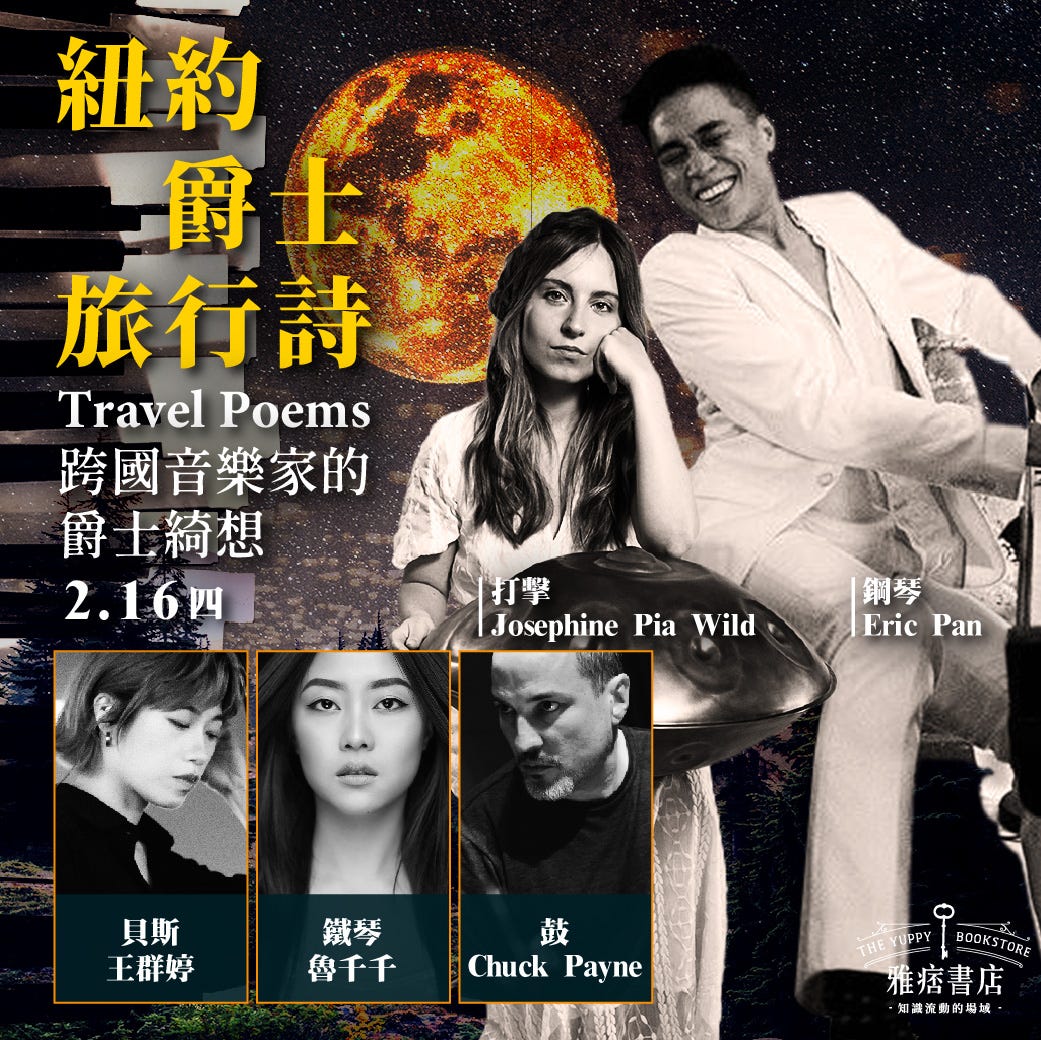
For the release of Chapter 3, I was curious to explore deeper collaborations. Teaming up with Mahzabin Haque for project management, we developed a multi-day exhibition where artists across disciplines could interpret the music + written postcards of Travel Poems through their own diverse mediums.
I began sending invitations to artists I admire.
I’ve been a fan of Hugo Faz despite never meeting them in-person: first as a Meme Card Artist for punk6529’s Memes project, where Hugo coordinated a video of a troupe on the rooftops of São Paolo — nude dancers covered in body paint, expertly choreographed for drone coverage.
Between filmmaking, photography, their own performance-art creations laden with wry critique of power structures, embrace of decentralized ownership as made possible by blockchain technology — and Hugo’s heart of absolute gold — I was elated upon receiving word that they were also a fan of my music and fully committed to this exhibition together.
Colin Aherne and I are kindred spirits in art: both creators of music and photography, and the interesting juxtapositions that occur through their combinations. Our conversations over the past year were, for me, a mix of surprises: that we worked in similar mediums and even aesthetics at-times, yet had divergent visions of what to express.
Hearing and seeing Colin’s work inspires me to imagine the possibilities of re-interpretations from vantage points similar and dissimilar to my own — in addition, his artistic choices prompt me towards reflective states that I feel would not occur to me even if I had taken photos from the same places on the same occasions.
I only witnessed a single performance by Camille Jackson, but was transfixed by her simultaneous expressiveness and restraint. As Travel Poems becomes more invitational to broader audiences, I’ve become increasingly appreciative of the response-impulse from a visitor towards the piece of music or art.
That moment someone decides to step inside the Teleporter, or listen to a story and imagine the environment described, such agency willingly committed is simultaneously a gift to the work, and a necessity for one’s actual experience of it. Camille’s creations seemed to welcome such commitment — and seemed to be “made whole” only when committed to by the visitor: the very same relationship I strive for in all my work. Invitations accepted are a big deal. I also resonate with her flair for improvisation, and am delighted that her range of movement vocabulary expands my mind.
Mahzabin introduced me to Carolina Boettner’s art — and immediately I was awed. Carolina’s transdisciplinary practices have taken her on explorations through science and ecology, video and other visual representations, live collaborations with improvised forms, and on and on.
For this project, Carolina proposed smell-art installations in dialogue with Travel Poems music and text, forming an indispensable foundation for our concept: to present music not merely as auditory experience. These would be interactive smells informed by a rich and wide understanding of culture, and expression of meaning, as it relates to the intimate bonds shared by travel and music.
I’ve been increasingly impressed by Magdalena Paz’s work over several years of knowing her, continually feeling astonished upon each revelation of yet another facet of her personality. Magdalena manages to channel herself directly through both painting and sculpture, despite their representative nature and possibility for distance from the self.
I feel her presence in her chosen subject-matter as well as the concurrent abstractness and playfulness exhibited in its execution — with clarity and intention. Recently, I learned that Magdalena also experienced an intensely on-the-go childhood. This surfaced a kinship to her and her work that I could sense but not articulate previously.
Finally, I invited ten musicians to create improvised music with me on each five nights of the exhibition: two to play the Travel Poems repertoire in trio-plus-dancer form for the final evening’s Album Release show, and eight to present their perspectives on music and travel in joint-collaboration.
The concerts are presented as open studios, in the manner of art-salons far older than even the Teleporter’s doors — where musicians are encouraged to pick up instruments as if they were lounging about, at home, spontaneously joining each other in duet or trio.
We sourced our exhibition title from the Travel Poems album liner notes — prefacing the postcard texts — written shortly after the songs were recorded:
The air is made of music. Atoms play, particles dance, ripe musical notes fall from shaking trees. Wherever we go, melodies appear — soundtracks begin performing themselves.
4 — Dissolution
As Travel Poems . Chapter 3 . There is no path back releases to the world, the end to the trilogy ushers a beginning of a different sort.
I see the story of Travel Poems as a single cloud’s life-cycle: music and sounds that once coalesced from the atmosphere, gathering for a spell: then inevitably dissipating again into water — or vapor.
But there will always be more clouds.
The Air Is Made Of Music expands upon the music and words of Travel Poems: when other collaborators join with their further remixes and panoply of perspectives, the project stretches into the future, unfolding in ever-unexpected directions.
Concretely: our TAIMOM exhibition, in October 2024, is but a first edition — so what happens next?
Artists around the world, commissioned to respond to the pieces presented here and now, on themes on travel and music, through their methods and their own lives.
Artworks re-scored with new music, alongside collaborations farther afield, involving, say, food combined with neuroscience.
As The Air Is Made Of Music grows, we’ll see exhibitions and performance-art conceptions and interactive installations built upon a foundation of transporting audiences through music and sound. The songs of Travel Poems needn’t be at the center, but their ideas live on, to tell new stories — and visit new destinations.
“Can home be the whole world?” (liner notes / postcard text for Chapter 1, track 9)
Can now be eternity?
Eric Pan
24 September ’24
Dear reader: what does travel mean to you?
Kindly reply to this email, or quote this issue with your response on Substack Notes, or send me a private message. I’ll reply with my impressions and, if you wish, typewrite your response on a card to hang in the exhibition space next week 💌.
Proof of Play // The 4-Fold Path
The daily-logging project is sometimes hard to keep up with, given this is the busiest time I’ve ever experienced (except for 7th grade which was obvi my peak) — but does feel more interesting when there is ample other stuff going on.
Day 241, “swift and wild our pulses” (4.5 hours’ logged studio time) —
Day 242, “all hands on deck” (2.75-hour log) —
Day 246, “mischief in the ice forest” (2-hour log) —
Day 247, “blanket of blue air” (¾-hour log) —
Sequel to a Memory
Growing up, sometimes the television would land on a cooking show, and I’d become gripped by the hullabaloo. But what I found most fascinating was not the food or the chef or my suddenly rumbling stomach . . . it was the logistics of how the TV crew had prepared the meals for various stages of readiness.
There would be a version of the cake batter that had already risen overnight.
And another version of the cake already baked — for the chef to blasély whisk out of the “oven” right after inserting another one, assembled live just moments prior!
All right: reflecting on this now, such logistics don’t seem to require galaxy-brain levels of architecture, but the image comes to mind because I find myself in the position of juggling multiple cakes at different phases of preparedness.
• Cake 1: Travel Poems, out soon in October. Ok.
• Cake 2: Recording the next album, its material secret, for reasons less-secret but still a bit secret.
• Cake 3: Publishing music from the studio every day, while not showing the secret stuff.
• Cake 4: Planning the sequel album to follow Cake 2 — they are connected and the follow-up is defined by its collaborative nature. This one’s now the most hush-hush, but needs to be shared with the potential collaborators.
Today, we ride . . . and continue the bifurcated divulgence! (Cool t-shirt slogan or nah?)
The Secret of Cake 2 is being unveiled for paid supporters of Campfire Sparks, one issue at a time. This current issue presents a transcription that completely unlocked a new dimension of the music for me:


